The Portland Bureau of Transportation wants to know if bike-friendly speed bumps are worth the trouble and treasure.
With an aim to slow down drivers and improve conditions for bicycle riders on neighborhood greenways, PBOT installed the first bike-friendly speed bumps (which they refer to as speed cushions) on SE Clinton street in 2017. The design includes two channels through the bumps that allow bicycle riders to roll through smoothly. Almost as soon as they hit the ground, the reviews from bike riders were very mixed. Some people love them, others say the channel is too narrow, can lead to crashes, and encourages drivers to swerve into them. Despite all that, PBOT has continued to use the not-yet-standard design citywide.
As we shared back in March, PBOT put out a survey to help determine whether or not they should continue to be part of the city’s traffic calming arsenal. The survey evaluated three things; rider preferences, the cost implications, and whether or not they actually reduced driving speeds.
PBOT Bicycle Coordinator Roger Geller brought results of the survey to the May 9th Bicycle Advisory Committee meeting and asked for feedback to inform a final report he’s working on.
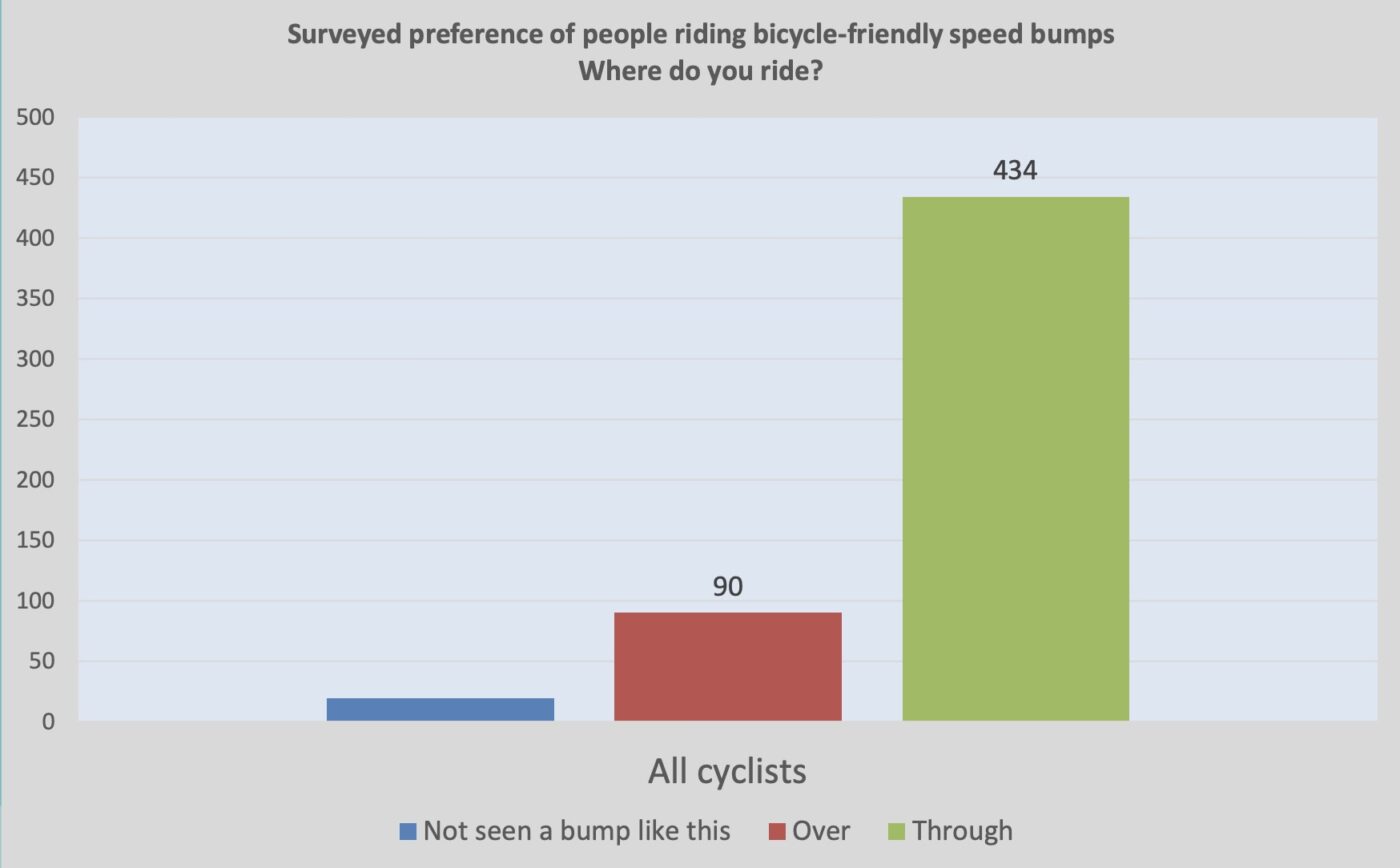
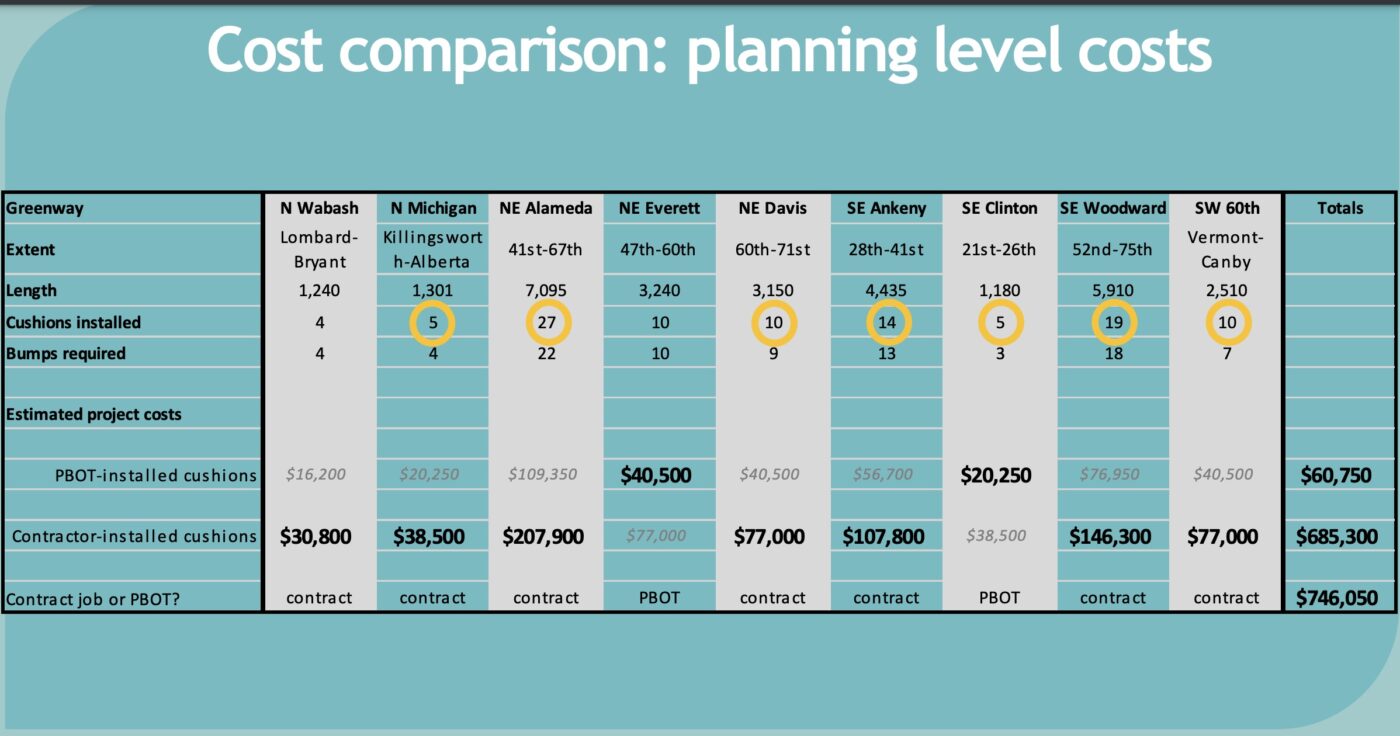
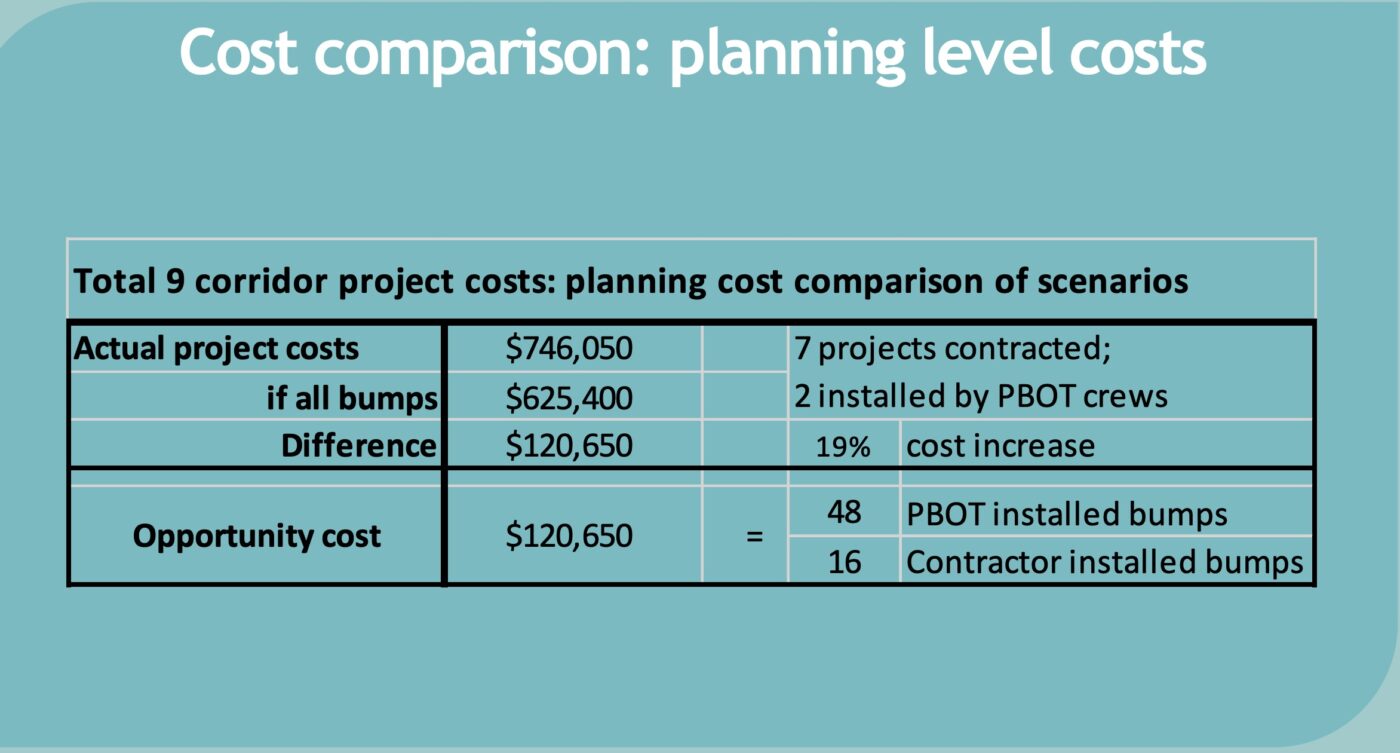
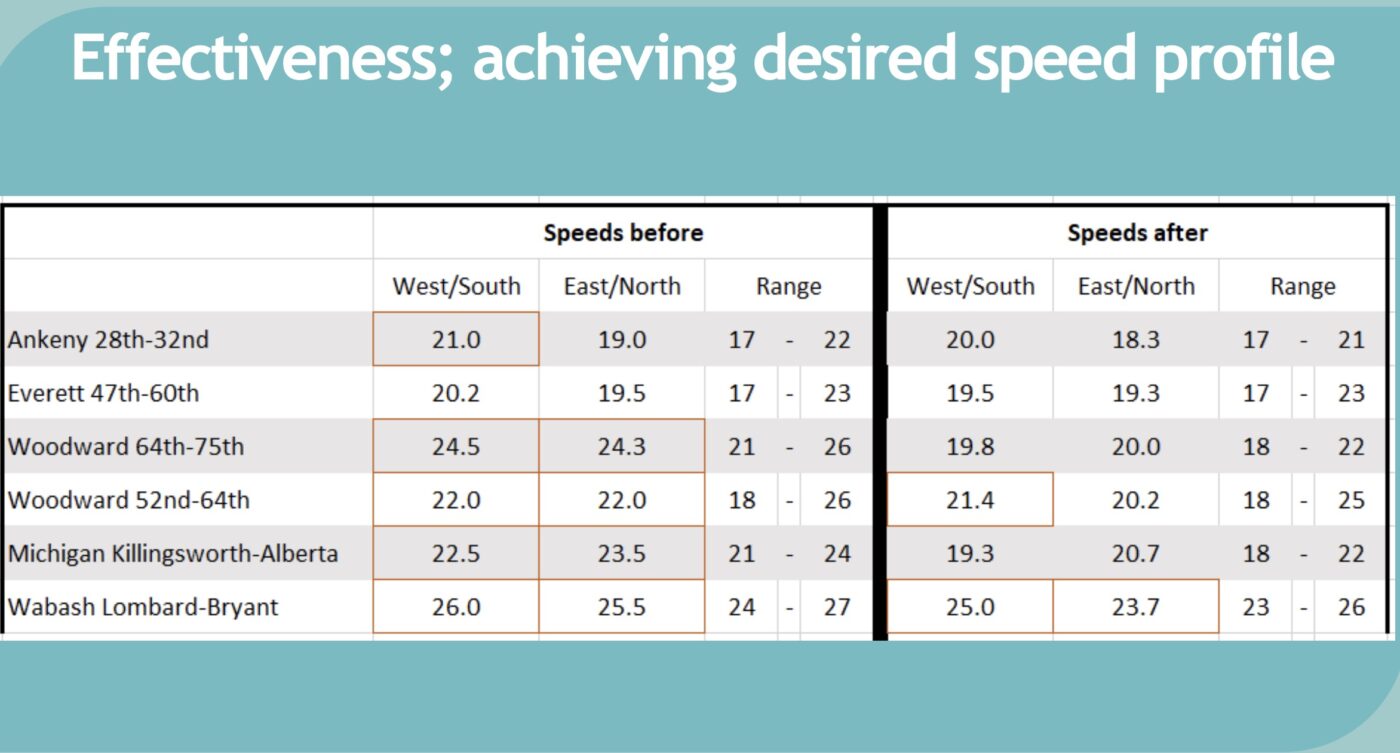
Of the 540 survey respondents, 80% said they prefer riding through the channel. Geller also did observations at seven different locations and found a similar number of channel-choosers. “People are voting with their wheels. That tells me the channels create a more comfortable cycling environment,” Geller said at the BAC meeting. And since Portland city policy is to create the highest-quality cycling environment possible, Geller says these bike-friendly speed bumps are more closely aligned with city goals than conventional bumps.
When it comes to the accompanying pavement markings, most people who took the survey said they prefer a sharrow marking to be aligned with the channel. Geller says this is important for two key reasons: 1) the sharrow will lead riders toward the channel in dark or low-light conditions and 2) the sharrow will encourage people to ride closer to the center of the lane, which he believes is the safest choice when using a neighborhood greenway.
According to the city’s survey and evaluations thus far, the bike-friendly bumps and traditional speed bumps have about the same impact on lowering driver speeds. So if they seem preferable to most cyclists and they accomplish the traffic safety goal, why not close the case and make them a standard treatment?
Because they cost more. About 20% more on average according to PBOT estimates.
And bumps (of any sort) are likely to only go up in price since PBOT will contract out even more of them in the future. The majority of bumps in Portland are already installed by private contractors, and with PBOT’s budget in the hole, their maintenance crews are likely to do even fewer of them in years to come. Geller shared at the meeting that it costs PBOT crews about $2,500 to install a traditional speed bump and $4,000 to install a bike-friendly cushion. When they contract that work out, the price balloons to $7,000.
Add in the fact that PBOT must install more bike-friendly speed cushions to the get the same speed reducing impact as traditional bumps, and the cost goes up even more. A comparison of nine recently completed neighborhood greenway projects showed that PBOT installed 104 of the cushions when only 90 bumps would have been required — spending a total of $746,050 on the bike-friendly ones when they would have spent just $625,400 on bumps without channels. That’s a 19% difference.
When PBOT asked in their survey if a 10% cost increase for the bike-friendly speed cushions would still be worth it, 51% of people said yes. 40% of respondents said it would be smarter to save the money.
There was also grumbling from BAC meeting attendees that folks would rather have diverters instead of bumps. Geller acknowledged that bumps aren’t intended to reduce car volumes like diverters are, and he also said concrete diverters are much more expensive. (Keep in mind PBOT considers those round concrete barrels to be only temporary solutions and the more permanent treatment of a median diverter, including design and signage is estimated to coast around $30,000 a piece.)
When you factor in the cost issues and PBOT’s unprecedented budget crisis, I won’t be surprised if we don’t see any more of these bike-friendly speed cushions in Portland.
We should know their fate soon. Stay tuned for Geller’s final report.


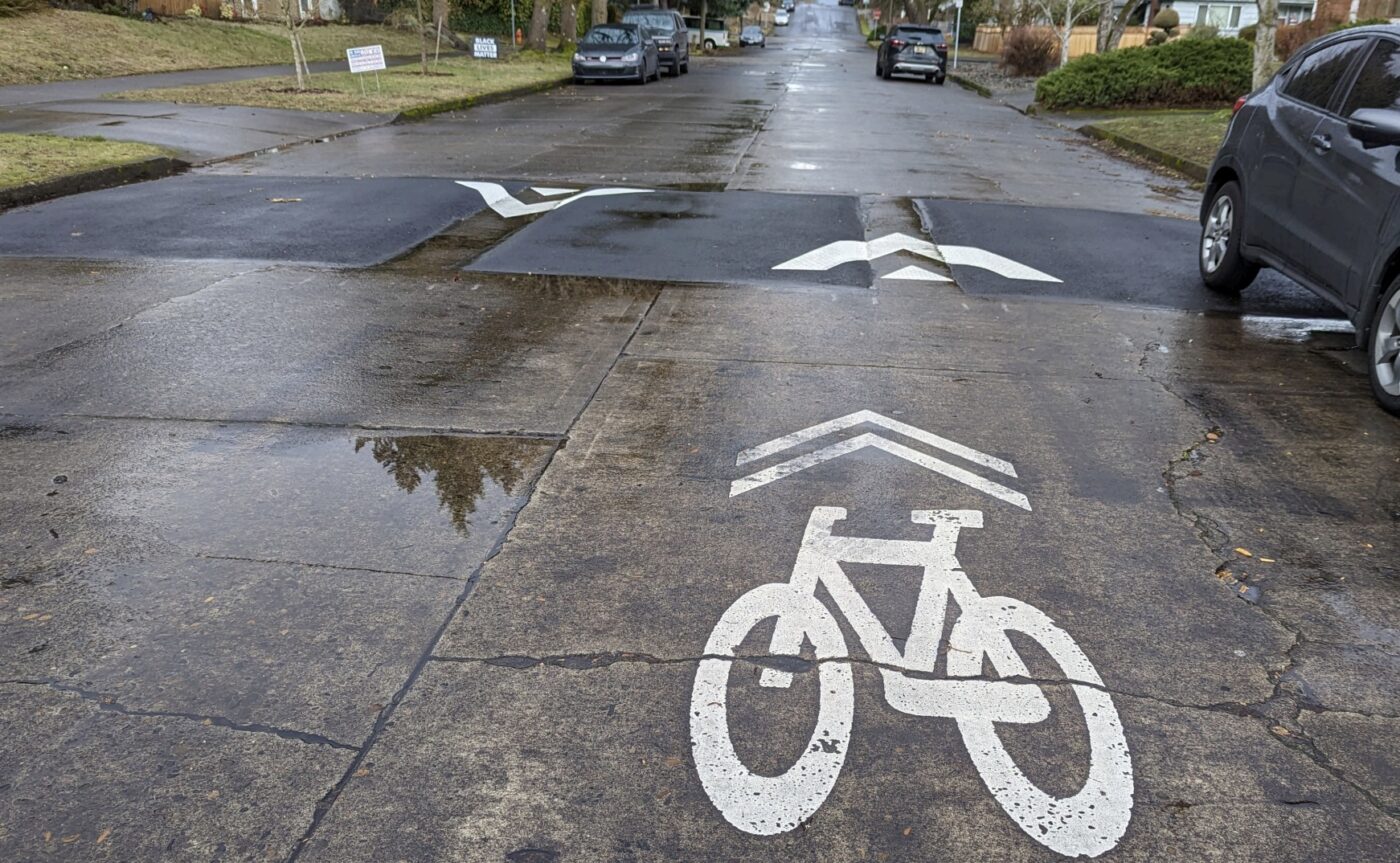
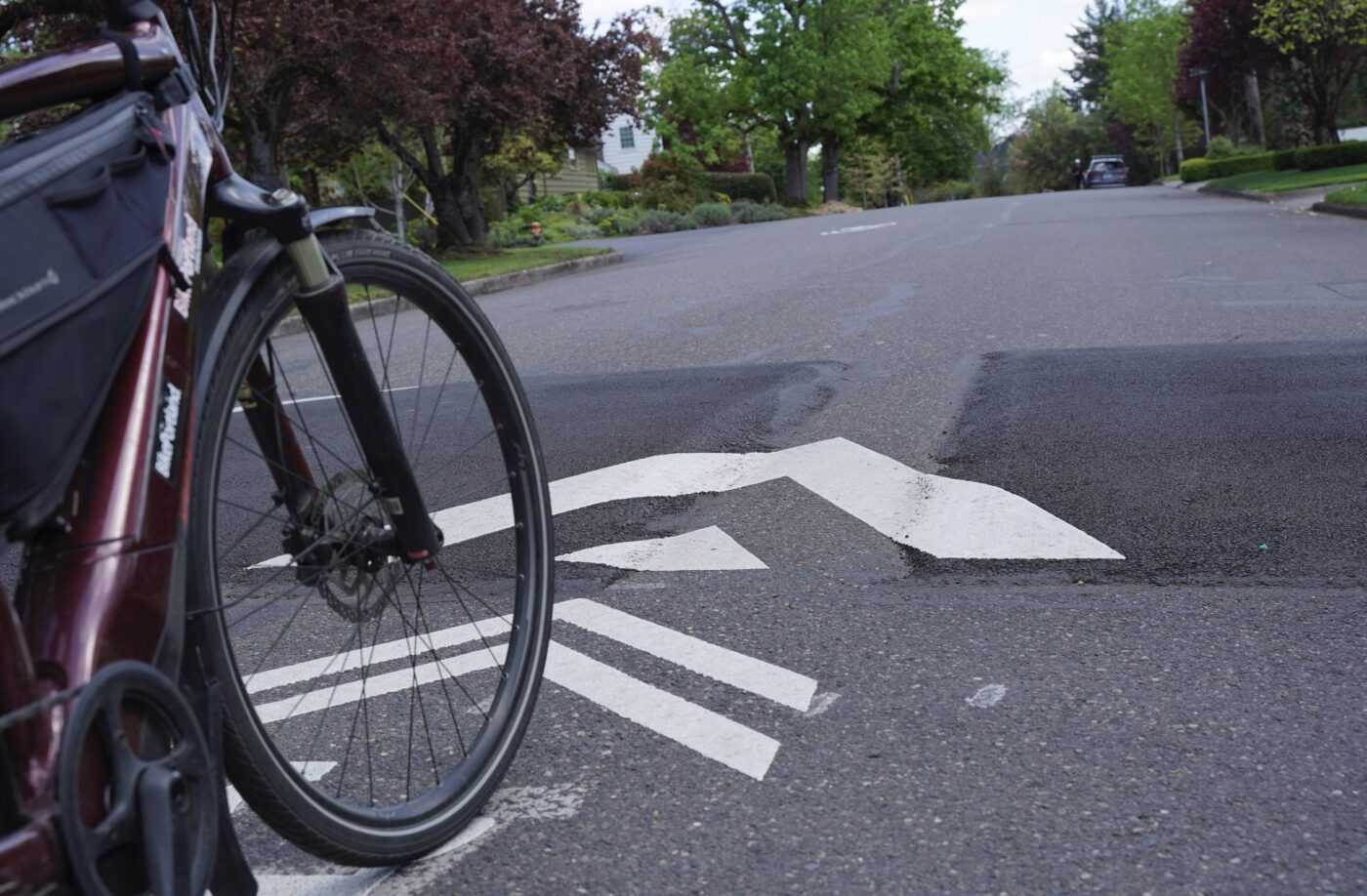
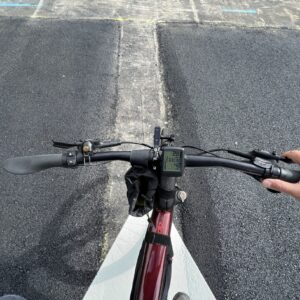
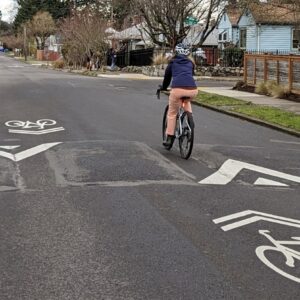
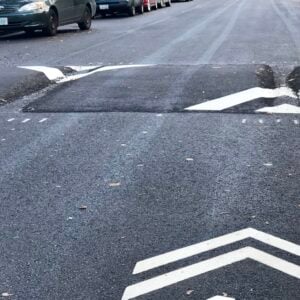
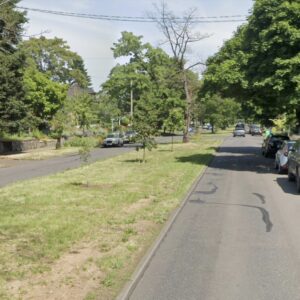
Thanks for reading.
BikePortland has served this community with independent community journalism since 2005. We rely on subscriptions from readers like you to survive. Your financial support is vital in keeping this valuable resource alive and well.
Please subscribe today to strengthen and expand our work.
Do the channels only help people on bikes, or do they also help fire / emergency vehicles? It seems that might change the math.
The emergency vehicle-friendly bumps are a separate thing. Typically those routes are not n’hood greenway routes and the fire-friendly bumps have a bit of a different design.
And SUV drivers. On many streets, they are able to cruise comfortably at 30+mph when this speedbump design is used. Try connecting from the Tillamook bikeway to the Halsey overpass on NE 92nd to see an extreme example firsthand. I never know if someone behind me is going to be doing 20mph or 50mph.
Oooof, so true. That transition (going south on 92nd and turning left onto the Halsey overpass) is def on Portland’s list of “Top 10 Mind Bogglingly Bad Bike Route Transitions”
I’d also like to formally submit to the list the slip lane on Alameda between 57th and 58th where, when traveling west, riders are encouraged to cross traffic right where vehicles are speeding off of Sandy onto Alameda.
There WAS a path planned that would run south from the East end of Hancock, and then go to a 205 underpass that would take you to the 205 pathway. It’s not a direct crossing of 205, but could work if you lived up near Maywood. I’ve emailed Ross Swanson and Melissa Arnold at PP&R a couple times, about this area. The undercrossing project is on hold until Better Red is done, and then maybe they’ll add in a path, but there are varied safety concerns with having an official path under 205 there. Please reach out to them with your concerns about biking on 92nd!
PBOT moves forward with I-205 path undercrossing project – BikePortland
Can the current undercrossing part be used to access Gateway Green or is it gated/secured?
Construction traffic only. It is gated, and trying to go through there when the gates are open would be a very bad idea.
They better freaking add a path there when better Red is done. They’ve graded it for construction traffic. It would just need pavement, fencing, and a transition up to the 205 MUP on the east end.
Currently there is a bunch of camper debris and such on the upper terrace, with a scramble path up to the 205 MUP at the North end of the bridge. They moved the corner of the construction fencing to let people go through there as campers kept cutting it.
From my 9/3/2021 email w/ Ross Swanson:
Funny how these “temporary solutions” have worked for decades in other cities that did not have a transportation bureau laser-focused on slow-walking* cheap and inexpensive ways to make neighborhood greenways attractive and safe.
*scoffing at the idea that neighborhood greenways should prioritize active transportation, burying inexpensive traffic calming under years of unnecessary outreach, requiring ridiculously expensive permanent installations etc.
And PDoT/ city’s public works department (PBoTs predecessor) also deployed concrete barrels and other precast object for diversion in the 1970s (or 80s/90s?) in the NW neighborhoods and these were in use for decades until recent capital projects had the budget priority to permanently fix the early/ mid century car centric intersection design flaws.
So with the current budget reality: CoP will need to revisit either using more precast (affordable) treatments [aka Quick Builds] or find the budget (political priority) to build in place treatments to address chronic traffic safety black spots / access barriers.
So worth it! (in my opinion) LOVE ‘EM!
that is hilarious! Did Geller say that? Delusional! PBOT exclusively designs bike infrastructure to be as good as it can be without a signal minor inconvenience to people driving or parking. Just please take a look at the north end of the Blumenauer Bridge and the obnoxious 90-degree s-curve across a sidewalk that bikes have to travel and tell me with a straight face the PBOT is creating the highest-quality cycling environment possible.
The obvious answer is the no bumps are best and cheapest- they don’t do much to control speed and they do nothing to control the dangerous presence of cars. Build NO bumps and use whatever money you have to build FUNCTIONAL diverters- not barrels or wands with 8′ gaps like Flanders.
If PBOT persists in building bumps, I think no gaps are better. The gaps are nicer, but they require precision. Since I am always sharing greenways cars, I sometimes get squeezed out of my preferred line of travel by them. I have encountered a bump while being close-passed and I ended up crossing the gap at an angle which is pretty sketchy at 15-20 mph. I think the hazard and cost is not worth the comfort.
The issue wasn’t the cutout, nearly everyone supports that, it’s that the cutout happens to be the width of a car’s wheels and they love to move towards the center of the lane to use them.
Make the cutouts further apart.
“Make the cutouts further apart.”
But wouldn’t that move bikes closer to the “door zone” of parked cars?
I often find that greenways with speed bumps are wide streets (not sure if it’s intentional or it’s just what I end up on (Lincoln, Clinton mostly). I actively veer towards the center to hit the cutout on my bike, and then veer back towards the right to allow others to pass if they wish.
We are talking about moving it a couple of feet out. It’s like they measured the width of an average cars wheel base and used that as a guide,fun stuff.
If it’s between cutout that matches the width of a car’s wheels and no cutout at all, I’m firmly in the “no cutout” group.
Eliminate the sharrows, which guide drivers to the center and merely indicate the obvious to cyclists. Eliminating them would also slightly reduce costs.
Sorry I missed this meeting and the detailed discussion. I am glad someone on BP answered the question as to if “no” speed cushions then would fire department not approve the use of ANY vertical deflection / traffic calming on this corridor type. (This was the case in Vancouver as to why we utilized speed cushions more often back in 2000 to 2009+…in order to get any traffic calming on routes that VFD had vetoed speed cushions on in the past (and future).
Jonathan, the other question I have is “why” are the speed cushion design(s) are “not yet standard design” for Portland?
Do you mean they are not in the city’s standard plans details?(I don’t have time today to look them up.) This treatment has been widely used for 20 years in the PNW region and other regions. See the links to the CoV details T02-23 to T02-25 bellow as an example…
CoV Transportation Details:
https://www.cityofvancouver.us/sites/default/files/transportation-standard-details/pdf/T02-23.pdf
https://www.cityofvancouver.us/sites/default/files/transportation-standard-details/pdf/T02-24.pdf
https://www.cityofvancouver.us/sites/default/files/transportation-standard-details/pdf/T02-25.pdf
https://www.cityofvancouver.us/transportation-standard-detail-section
This is a great example of PBOT spending thousands of dollars to avoid inconveniencing motorists.
PBOT would rather spend $7k a couple of times each block on something that doesn’t work rather than install permanent traffic diverters once every four blocks, which are probably cheaper.
PBOT fundamentally sees greenways as being designed primarily for motorist speed and access. Until that changes, it’s a misappropriation of taxpayer money to even have the signs made.
I know, it’s crazy that they might actually care what the majority of residents want.
No chance the majority of residents on any greenway prefer unfettered automobile access to a slow street that retains local access. Living on a high traffic street is quite stressful (louder, smellier, etc.) compared to a quiet neighborhood block – everyone knows this, even people who only ever drive to get around.
Car drivers sure love to aim for them so they don’t have to slow down. Like what even is the point of having these little speed humps if drivers can just aim for the gaps? First time I saw them I figured it was just some new sort of concession to drivers that complained. Personally I’d prefer traffic diverters on greenways and not these speed humps that do little to slow down cars
I worked construction during college and observed road construction when I was an agency manager. I don’t see why the “friendly” speed bumps should cost an extra $1500. Materials cost the same; equipment should be the same. The difference must be in the time it takes for the crew to place the asphalt and feather the edges of the channels. Assuming a five-person crew, that suggests it takes an extra two hours to create the channels. Sorry, but it doesn’t add up for me. Maybe they just need more practice.
The difference is when the companies bid a government contract, the price goes up up up!
Seriously. PBOT doesn’t have the money to build these, but does have the money to pay far more for a contractor to do the work.
We don’t need speed bumps if there were diverters every 3 blocks on greenways.
Absolutely agree with this, the problem is too many cars being driven on greenways, many cars can take speed humps at greater than 20mph so they aren’t actually even enforcing the speed limit and they do nothing to lower motor vehicle volumes. Greenways should have diverters at frequent intervals.
What’s a diverter? Does anyone have a photo?
A diverter is a little infrastructure that allows bikes to continue straight but makes cars turn right. The attached image is from 20th/Ankeny. There are 3 short sections of concrete curb with plastic wands. The gaps are about 3′-4′, and the total length is about 36′- the width of Ankeny. here is also a right turn arrow pained on the street, and a sign instructing users that there is no straight or left movements except for bikes. Somehow this is wildly more expensive than 3-5 asphalt speed bumps!
Sewer barrel diverter installations cost ~$5-7k so are less expensive than adding a bunch of speed bumps.
I don’t think speed bumps are as big of an issue for cycling comfort as the actual pavement itself. The other day I saw a “bike friendly” speed bump with the pavement heaved, cracked, and totally uneven on the entire block the bump was on, including the channel in the speed bump. But yeah let’s blow 7k on SUV-friendly speed “cushions” I guess.
Hahah right, like on Davis. The smoothest part of the road now are all the bumps they added a few months ago.
Has a anyone crashed or tipped on these? I was trying out a big 2-wheel cargo bike when I encountered them and I was a wobbly new rider…I was terrified that if I didn’t aim perfectly through the channel, my wheel would “catch” and tip the whole cargo box… but maybe I was unreasonably afraid? Or has someone tipped? I was too nervous to test the theory, but I was pretty nervous and sometimes opted to ride over the hump so as to avoid the question altogether. My cargo trike wouldn’t handle those well. But I can just slow and ride over the bump, if they are helpful to the majority of bikers.
Yep, I crashed on one once when they were new. It was at night, and I turned at a sharp angle to avoid some construction debris in the road. I did see the speed bump but didn’t notice that there was a cutout. I had no idea that these cutouts even existed at the time. I was on narrow 25mm tires and hit the steep part of the cutout at just the wrong angle.
I think they could be improved by having some markings to indicate that there’s a cutout and by making the walls of the cutout less steep.
I’ve had a pedal strike the hump on one as I went through the channel while pedaling. That messed up the bearing on the pedal that struck it.
I ride a 2 wheeled cargo bike and sometimes hit these right at the edge or in an awkward spot. I have never crashed or tipped but they make me feel nervous and going through the channel is barely more comfortable than just going over the hump. I could totally see a new rider on a bike like mine messing up with these and going down.
I have had a pedal strike, but didn’t go down
Yes, I’ve crashed on the ones on 28th street. They are probably the worst implemented version of the “bike-friendly” humps.
The ones on 28th were not intended to be bike-friendly. They were supposedly intended to be emergency-vehicle friendly.
I’ve tried hitting them in all sorts of oblique angles and have never been able to trigger a problem. With the exception of the unholy crap pile that are the bumps along NE 28th. Those are dangerous and PBOT should be ashamed of themselves.
Every fourth “speed cushion” is a fifth speed bump never built at all.
Now feels as good a time as ever to note that I was in a meeting with a former PBOT employee just yesterday who said “speed bumps don’t slow down drivers.” That’s depressing, but the story checks out.
The best I’ve seen a speed bump accomplish is to temporarily slow down a driver while they are going over the bump, and then the driver accelerates immediately after the bump until they hit the next one. It’s the same mentality as drivers who aggressively accelerate past cyclists to get to a stop light, only to have the cyclists catch up to them and wait in the bike box for the green light and start the passing cycle over again.
Nothing will slow down drivers besides narrow streets that would also be dangerous for bikes, we either need to install diverters to keep drivers off of greenways or we need to install protected bike lanes on all the greenways to separate the traffic, the speed bumps aren’t doing it.
We need PBOT / Commissioner Mapps to reinstate the Traffic Calming Division, in part so that bumps and other calming tools that are needed community-wide aren’t siloed as a bike thing. Oh and +1 for the channels.
do people like them though? I have noticed that they often encourage motor vehicle operators to swerve across the center line in an attempt to avoid the bump, I was nearly hit head on while riding on 28th. I think it is safer not to have the channel.
Betteridge’s law of headlines says “no.”
What’s most striking to me in the screenshots of the presentation slides is that the effect on driver speeds is negligible to not-at-all. So why even bother with any speed humps? That’s a much better cost-saving. If they’re not making cyclists safer – dump them. Then, maybe they could afford some diverters.
There is strong institutional resistance to using diverters for traffic calming at PBOT. Instead of seeking to apply political pressure on PBOT leadership and civil engineers, many cycling activists still act as if PBOT staff are their friends.
Those are average speeds. In my experience, these bumps help most with the excessive speeders. No one is going 50mph next to Rose City golf course now that they have speed bumps (without cutouts, thankfully). I had encountered that many times before the installation.
This was my thought, too. A great example of how (and which) statistics are used to tell a story. Is the goal is to eliminate the top in speeders? Then share that data. Is the goal is lower overall speeds? Then show the data that was shared.
A diverter is even more effective at reducing the top end speeding on greenways
As others have noted, simply prioritize diverters instead of these relatively inconsequential bumps.
Now, why can’t PBOT add “May Use Full Lane” as a default sign on all greenways? Strange that even the greenways are prioritized. For example, it’s emblazoned on Ankeny but not on Sacramento.
Those signs came about only because cycling advocates and cycling-friendly community members vigorously lobbied for them. PBOT very reluctantly installed them.
This is my biggest problem with these cushions. They’re not consistent at all. Some are so low that cars can easily go over them at 30+ mph others are effectively high enough to slow most drivers down. Then the cutouts are all different widths and placed in inconsistent places. And as others have noted they’re almost always spaced perfectly so that large SUVs and trucks can roll right through them. It’s almost as if the people installing them did it on purpose.
The ones on Harrison in between 26th and 30th are some of the worst. Perfect spacing for cars and their placement is off so that you can’t safely use the eastbound cutouts if there’s oncoming traffic because it places you too far to that side of the road. Especially when there are cars parked on the road.
The one at Everett and 55th is also particularly bad and will eventually if it hasn’t already cause someone to crash. Where it’s placed is in a spot that people will naturally approach at an angle when going east which will mean you go over them instead of through them. An as jarring experience as an unexpected pothole.
Sort of like the ‘diverters’ at 15th & Ankeny: Wide enough for cars to pass through! It makes you wonder why our hard earned taxes are spent on nonsense like this? And no explanation from our public servants, at least no satisfactory one.
https://bikeportland.org/2018/12/14/new-diverters-on-ankeny-and-lincoln-part-of-plan-to-keep-drivers-off-side-streets-293190
idlebytes: your comment points to the need for consistent design and thus having an engineering design detail for them vs each contractor “crafting” them in a bespoke manner and then the judgement of the on site construction inspector to approve.
“the bike-friendly bumps and traditional speed bumps have about the same impact on lowering driver speeds”
the way I read those tables, there was no effect on speed (before, after).
Please explain!
And while you’re at it, please explain the speed cushions on the one-way, one lane, super narrow, half block on Ankeny btw SE 32nd & SE 33rd. How was it decided to put those there?! What is their purpose?
Baffled.
Being antagonistic toward residents primary transportation choice is the first priority for many, regardless of cost.
Yep, car-obsessed people will fight tooth and nail against better bicycle infrastructure, even though it can lead to decreased car traffic volumes and costs far less than car infrastructure. Or is that not what you meant?
I ride my friend’s triple and having a slot would help avoid bottoming out in the middle of the speed hump. Without the slot, we have to go very slow, keep pedals centered and hope for the best or come to a very sudden stop.
what is a triple?
It’s basically a double, but a bit more.
There’s a clear case for the city to bring more of this work in-house to save money. Almost twice the cost to contract out the work is ridiculous.
A bike-friendly speed bump would have prevented my recent bike fall. To be clear, this was my fault, I was going too fast on a cargo bike when I hit the bump. When I came down, I came down on my elbow and doctors needed to screw it back together. As far as the extra cost to build these right? Yes, worth it.
The ones on NW Cornell are pretty thrilling, but I wonder if it would be bad if I missed the gap.
It seems as though PBOT has once again failed at basic outreach. I am not surprised… A. For streets that are on emergency routes, the cutouts are for them. Not for bikes. Do I use them? Yes. Why, because people like Scott Cohen has trouble understanding basic upgrades that can both benefit cyclists and slow traffics down. What do I mean? Well, gone are the days where the middle of the bumps that had 2 cutouts so emergency vehicles could use them and other traffic couldn’t. Why did they change the cutouts to have 3 instead of two? I don’t know. It was a terrible one and now PBOT has to make all kinds of additions just to barely make them work. What additions? Silly markers that they put 3 feet outside of them that they somehow think will get drivers to avoid taking the outside palpate of them to cut through. These don’t work. Streets like SE Duke literally have speed bumps in the bike lane. Lol. I stopped riding Duke. I’ve produced better concepts to deaf ears like Rick Nys. Must be nice to earn 6 figures and waste the public’s money. B. SE Clinton and other greenways received them after years of begging because not everyone is an able bodied 20 something. I have back issues. I avoid any kind of disturbances on my ride which means I often take the lane on Woodstock because the bike lane is not rideable. As far as people hitting them with pedals and having issues with trikes and trailers, you legit have 90% leftover so you don’t have to use them. But, I will never understand slowing cyclists down. Bumps slow us down. They add extra hits to your body and are especially for cars. Keep them that way. Merely saying that “slowing cars down is the only way is thoughtless.” I’ve heard that from my NA Chair and from the Hardesty admin. We live in a former creative town and have now become stagnant in our approach which is sad.